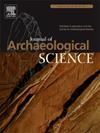通过研究狗的内脏变化来识别狗的习惯性拉雪橇
IF 2.6
1区 地球科学
Q1 ANTHROPOLOGY
引用次数: 0
摘要
雪橇犬是北方最具代表性的动物之一,它们拉雪橇的努力促进了贸易和维持了许多土著群体数千年的生存方式。不幸的是,狗拉雪橇的历史很难在考古学中找到。在过去,狗拉雪橇的鉴定主要是通过狗的骨骼遗骸与雪橇和挽具的材料部件的联系来解决的。然而,目前还没有办法直接从犬科动物遗骸中识别雪橇活动。这篇文章介绍了一个新的视觉评分手册,以解决这方面的知识差距。窝骨变化是窝骨的形态学变化,窝骨是骨上的肌肉、肌腱和韧带附着部位。它们被用来重建人类过去的活动,最近也被用来重建驯鹿和马科动物的遗骸,但从未用于重建犬科动物的遗骸。采用74只工作雪橇犬、非工作宠物犬和野生犬科动物对前肢和后肢进行了13个实验。研究人员比较了视觉评分,以检查运动对内脏变化的影响,但也混淆了年龄、性别和体型等生物因素。还进行了观察者误差测试,以确定方法的精度和可重复性。结果表明,雪橇犬的得分明显高于非工作犬,尤其是在7个附件上。这表明,尽管一些附着物比其他附着物更能反映工作活动,但在形态学上,这些附着物对习惯性拉雪橇很敏感。总的来说,这些发现表明,该方法可以区分雪橇犬与宠物狗和野生犬科动物,并且是识别考古犬科动物遗骸中雪橇活动的有用工具。此外,这种方法将有助于更好地了解北方人狗关系的历史和发展。本文章由计算机程序翻译,如有差异,请以英文原文为准。
Identifying habitual sled-pulling in dogs through the study of entheseal changes
Sled dogs are among the most iconic animals of the North, and their efforts in pulling sleds facilitated trade and subsistence practices that sustained many Indigenous groups for thousands of years. Unfortunately, the history of dog sledding is difficult to trace in archaeology. The identification of dog sledding in the past has been mostly addressed through the association of dog skeletal remains with material parts of sleds and harnessing equipment. However, there is currently no method for identifying sled-pulling activity directly from canid remains. This article introduces a new visual scoring manual for entheseal changes to address this gap in knowledge. Entheseal changes are morphological variations to entheses, which are muscle, tendon, and ligament attachment sites on bone. They have been used to reconstruct past activity in humans and, more recently, reindeer and equid remains, but never in canids. This method was developed for thirteen entheses on the forelimb and hindlimb using 74 working sled dogs, non-working pet dogs, and wild canids. Visual scores were compared to examine the effect of activity on entheseal changes, but also confounding biological factors such as age, sex, and body size. Observer error tests were also conducted to determine the method's precision and repeatability. The results show that sled dogs have significantly higher scores than non-working canids, especially for seven attachments. This suggests that entheses are morphologically sensitive to habitual sled-pulling, though some attachments are better indicators of working activity than others. Overall, these findings demonstrate that the method can differentiate sled dogs from pet dogs and wild canids and is a useful tool for identifying sled-pulling activity in archaeological canid remains. Furthermore, this method will help to better understand the history and development of human-dog relationships in the North.
求助全文
通过发布文献求助,成功后即可免费获取论文全文。
去求助
来源期刊

Journal of Archaeological Science
地学-地球科学综合
CiteScore
6.10
自引率
7.10%
发文量
112
审稿时长
49 days
期刊介绍:
The Journal of Archaeological Science is aimed at archaeologists and scientists with particular interests in advancing the development and application of scientific techniques and methodologies to all areas of archaeology. This established monthly journal publishes focus articles, original research papers and major review articles, of wide archaeological significance. The journal provides an international forum for archaeologists and scientists from widely different scientific backgrounds who share a common interest in developing and applying scientific methods to inform major debates through improving the quality and reliability of scientific information derived from archaeological research.
 求助内容:
求助内容: 应助结果提醒方式:
应助结果提醒方式:


